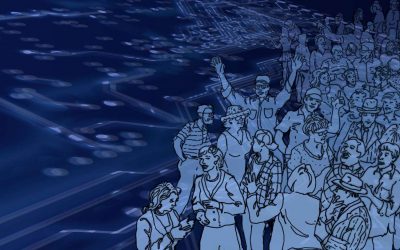When search engines such as Google scour the Internet for the best results, there’s a series of algorithms — set of rules to solve a problem — at play. But algorithms live well beyond cyberspace. Human and animal social groups also establish hierarchies and power structures based on making sense of information in their groups.
Scientists know algorithms are useful to find valuable information in computer and social networks, but it’s not been clear what exactly makes the algorithms effective.
A research team at the Center for Complexity and Collective Computation (C4), a research center in WID, has started to explain why certain algorithms are successful at measuring the consensus present in groups. The work was summarized in a recent paper published in the journal PLoS Computational Biology.
“Animals and people may be using surprisingly similar algorithms to make decisions about how to behave in their social groups,” says Eleanor Brush, a graduate student in the Quantitative and Computational Biology Program at Princeton University and visiting graduate fellow at C4.
Brush, along with Jessica Flack, co-director of C4, and David Krakauer, professor of genetics and co-director of C4, studied different types of social groups to confirm whether there are consistent ways to measure the degree of consensus among a group’s members and what the consequences of that consensus are.
“Animals and people may be using surprisingly similar algorithms to make decisions about how to behave in their social groups.”
— Eleanor Brush
For instance, in primate groups, the consensus about a particular monkey’s fighting ability affects both how it manages conflict and how other monkeys behave around that individual. In scientific communities, consensus about a scientist’s ability to collaborate can affect his or her prestige and success in publishing papers in peer-reviewed journals and receiving awards. Members of social groups form opinions about their peers’ abilities and behaviors, and the consensus in these opinions can affect how the group members behave in the future.
Drawing on methods from network theory, computer science and animal behavior, the researchers found that the number and consistency of an individual’s direct connections can predict his or her role within the group. In primate groups, knowing which monkeys communicate their subordination to a particular individual may be sufficient to judge how powerful that individual is.
In some systems, using indirect connections can provide even more information. For example, knowing not only which people a scientist has collaborated with, but also with whom those individuals have collaborated improves the prediction of that scientist’s success.
Based on the findings, Brush and colleagues say consensus may hold importance in many systems, from friend networks to economic trade systems. The results suggest that the signature of consensus is similar in these very different contexts. In future work, they will study why animals and people decide to communicate their opinions about their peers and how consensus in these opinions develops over time.
The research was made possible through the support of the John Templeton Foundation.
— Marianne English

